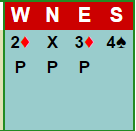For once, I don’t mean bidding/playing tempo and hesitations. Rather, I’d like to provide an example of counting tempos in the play. The simplest example is, say you are defending 3NT, and the opponents lead a suit where all you have is Ax opposite xx. They have the «tempo», that is, the moment they knock out your ace, you better have 9 tricks, or you’re going down.
Here is a routine play problem.
 |
Lead: ![]() K
K
They lead a high diamond and switch to a trump. Plan the play.
⇓
⇓
⇓
⇓
⇓
⇓
⇓
⇓
⇓
⇓
⇓
⇓
⇓
⇓
⇓
I won in dummy, cashed two rounds of hearts (pitching a diamond), and attempted to ruff my other losing diamond. When nothing good happened in clubs or hearts, I ran out of trumps and went down.
So where did I go wrong? (This is the real exercise. If your play was correct on the previous page, you will already know why.)
I got lazy. If I’m counting tricks, I should be able to come to six high trumps, two high hearts, one diamond ruff, and one club, provided I can keep control.
How do I know whether I can keep control? If nothing good happens in clubs (e.g. no ace-or-queen correctly guessed onside), I need two tempos to force out a club trick on power (given the lead, LHO probably has the ![]() A-K and won’t have much else). Each time, the opponents can attack my long trump holding. The way you should think about it, each «tempo» (in a trump contract) is like being forced to draw another round of trumps.
A-K and won’t have much else). Each time, the opponents can attack my long trump holding. The way you should think about it, each «tempo» (in a trump contract) is like being forced to draw another round of trumps.
If trumps are 3-2 (I need to draw at least three rounds), and adding in the two club tempos, that gives me only one remaining trump to ruff in hand. If trumps are 4-1, then I’m going to need some luck in either clubs or hearts.
Now, it should be clear to win the first trick in hand (by overtaking either the jack or king) and immediately ruff a diamond, and then continue as before.
Of course, the opponents could have set me with a club lead or switch, but when they didn’t, I failed to capitalize. Indeed, my «wastage play» of winning the first spade in dummy would have failed even if clubs were two-two (A-Q offside).
